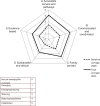Evaluating the role of Cardiac Genetics Nurses in inherited cardiac conditions services using a Maturity Matrix
- PMID: 24013169
- PMCID: PMC5407505
- DOI: 10.1177/1474515113502748
Evaluating the role of Cardiac Genetics Nurses in inherited cardiac conditions services using a Maturity Matrix
Abstract
Background: Cardiovascular disease is a leading cause of death worldwide and genetic risk factors play a role in nearly all such cases. In the UK, health service capacity to meet either current or future estimated needs of people affected by inherited cardiac conditions (ICCs) is inadequate. In 2008 the British Heart Foundation funded nine three-year Cardiac Genetics Nurse (CGN) posts across England and Wales to enhance ICC services. The CGNs were experienced cardiac nurses who had additional training in genetics and acted to coordinate cardiac and genetics service activities.
Aim: To create and apply a framework against which progress in ICC service improvement could be measured over time following the CGN appointments.
Methods: A performance grid (Maturity Matrix, MM) articulating standards in five domains against stages of ICC service development was created by stakeholders through a consensus approach. The MM was used to guide staged self-assessments by the CGNs between 2009 and 2011. A six-point scale was used to locate progress from 'emerging' to 'established', represented graphically by spider diagrams.
Results: Progress in all domains was significant for new, emerging and established services. It was most notable for effective utilisation of care pathways and efficient running of clinics. Commitment to family-centred care was evident.
Conclusion: The ICC-MM provided a comprehensive framework for assessing ICC services and has merit in providing guidance on development. CGNs can help integrate care across specialisms, facilitating the development of effective and sustainable ICC services at new, developing, and more established ICC service locations.
Keywords: Cardiac genetics; ICC services; consensus techniques; inherited cardiac conditions services; maturity matrix; nurses.
© The European Society of Cardiology 2013.
Conflict of interest statement
Figures









Similar articles
-
IMPROVING CARDIOVASCULAR NURSE-LED HEALTH SERVICES.Aust Nurs Midwifery J. 2016 Apr;23(9):22. Aust Nurs Midwifery J. 2016. PMID: 27254985 No abstract available.
-
20 things you didn't know about European cardiac nurses.J Cardiovasc Nurs. 2014 Jul;29(4):291-2. doi: 10.1097/JCN.0000000000000109. J Cardiovasc Nurs. 2014. PMID: 24911107 No abstract available.
-
Mainstreaming genetics: a comparative review of clinical services for inherited cardiovascular conditions in the UK.Public Health Genomics. 2010;13(4):235-45. doi: 10.1159/000279625. Epub 2010 Apr 15. Public Health Genomics. 2010. PMID: 20395692 Review.
-
Building the capacity for evidence-based clinical nursing leadership: the role of executive co-coaching and group clinical supervision for quality patient services.J Nurs Manag. 2007 Mar;15(2):230-43. doi: 10.1111/j.1365-2834.2007.00750.x. J Nurs Manag. 2007. PMID: 17352707
-
A review of prison health and its implications for primary care nursing in England and Wales: the research evidence.J Clin Nurs. 2007 Jul;16(7):1201-9. doi: 10.1111/j.1365-2702.2007.01799.x. J Clin Nurs. 2007. PMID: 17584337 Review.
Cited by
-
Current Genetic Service Delivery Models for the Provision of Genetic Testing in Europe: A Systematic Review of the Literature.Front Genet. 2019 Jun 19;10:552. doi: 10.3389/fgene.2019.00552. eCollection 2019. Front Genet. 2019. PMID: 31275354 Free PMC article.
-
Implementation of genetic testing for heritable cardiac conditions: A scoping review.Genet Med Open. 2025 Jun 30;3:103441. doi: 10.1016/j.gimo.2025.103441. eCollection 2025. Genet Med Open. 2025. PMID: 40756326 Free PMC article. Review.
-
A self-assessment maturity matrix to support large-scale change using collaborative networks in the New Zealand health system.BMC Health Serv Res. 2024 Jul 24;24(1):838. doi: 10.1186/s12913-024-11284-6. BMC Health Serv Res. 2024. PMID: 39049084 Free PMC article.
-
A Maturity Matrix for Nurse Leaders to Facilitate and Benchmark Progress in Genomic Healthcare Policy, Infrastructure, Education, and Delivery.J Nurs Scholarsh. 2020 Sep;52(5):583-592. doi: 10.1111/jnu.12586. Epub 2020 Jun 27. J Nurs Scholarsh. 2020. PMID: 32592453 Free PMC article.
-
A prospective cohort study assessing clinical referral management & workforce allocation within a UK regional medical genetics service.Eur J Hum Genet. 2015 Aug;23(8):996-1003. doi: 10.1038/ejhg.2015.33. Epub 2015 Mar 11. Eur J Hum Genet. 2015. PMID: 25758997 Free PMC article.
References
-
- Burton H, Alberg C, Stewart A. Heart to heart. Inherited cardiovascular conditions services. A needs assessment and service review. Cambridge, UK: PHG Foundation; 2009.
-
- Kim L, Devereux R, Basson C. Impact of genetic insights into Mendelian disease on cardiovascular clinical practice. Circulation 2011; 123: 544–550. - PubMed
-
- Behr E, Dalageorgou C, Christiansen M, et al. Sudden arrhythmic death syndrome: Familial evaluation identifies inheritable heart disease in the majority of families. Eur Heart J 2008; 29: 1670–1680. - PubMed
Publication types
MeSH terms
Grants and funding
LinkOut - more resources
Full Text Sources
Other Literature Sources
Medical

